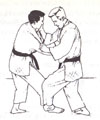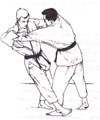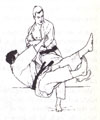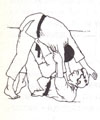




| Home Judo Books Translation Coaching Sumo Archives Contact |
| Sumo |
For advice & information on sumo in Japan and UK contact: info@sydhoare.com |
SUMO, GAMBLING AND THE YAKUZA The Japanese sumo world has been having a bad time in the last three years or so since Eurosport TV stopped televising it. Firstly there was the increasing problem of Mongolian Yokozuna Asashoryu who was getting out of control. He was far and away the strongest rikishi who did what he wanted to do which meant for instance turning up late for important sumo ceremonies at the Meiji-shrine, taking breaks in Mongolia on the pretext of being injured or out of shape but somehow forgetting that the media are everywhere who filmed him playing soccer. Another of his sins were bullying lower ranked wrestlers which in itself was not so bad but which irritated the older directors and stable bosses especially during the Jungyo provincial tours between each basho. In short Asashoryu took control of the training, acting like a gaijin (foreigner) who did not know how things were done in Japan. Nobody it seemed could control him either in the dohyo (sacred ring) or off it. Then there were allegations of his match rigging (yaocho) which were a bit strange considering he could beat all of them anyway and the subsequent libel case which is expected to last a few years. Eventually Asashoryu was banned from a couple of basho (tournaments) which was a first for Japanese sumo and then he was excluded permanently after he got in a fight outside a night club in Tokyo. Asashoryu has probably had enough of sumo. He had placed at No.3 in the all-time historic list of won bashos (after yokozuna Taiho and Chiyonofuji) and first entered the makunouchi division in 2001 equalling ten years at the top. Perhaps more to the point was the fact that the sumo money was drying up. Follow the money too understand sumo! No Japanese wrestler was capable of challenging Asashoryu in the ring or qualifying as Yokozuna but what the Japanese public really wanted was a Japanese rikishi who didn’t keep hitting the headlines for his ‘bad’ behaviour and who could win two basho in a row with a score of 12 plus wins per basho or 36 wins in total over three consecutive basho. This would have met the promotional requirements for Yokozuna. Unfortunately there was only one other person who could do just that but he was also from Mongolia and fought under the name of Yokozuna Hakuho. He was a mild mannered wrestler who behaved correctly in and out of the ring most of the time which endeared him to the Japanese public. Nevertheless he was not Japanese. However the money was drying up. The Japan Sumo Association which controls everything to do with pro-sumo in Japan (except the ownership of the 48 or so stables where the wrestlers live and train) controls the money that comes in from sumo and times have been hard for a number of years. The Japanese economy has been ‘stagflating’ with constantly dropping prices for some years now. The Sumo Association depends on bums on tournament seats, TV rights, and sponsorship of one sort or another to keep going but the salaries of the wrestlers had not risen for well over five years. Perhaps it was poverty that pushed them into gambling. The Sumo Association had started to sell off some of its assets and the flow of young sumo hopefuls into the game was shrinking. This was not helped by the death of one teenage novice wrestler from bullying in one of the stables. The match rigging mentioned above was not new to sumo. The sumo slang for it is Yaocho which was the name of a green grocer (yaoya) who was caught doing it about one hundred and fifty years ago. Rigging has been going on for quite a long time but it tends to happen towards the end of each tournament. The aim of each wrestler is to (1) Either end up winning the most number of tournament bouts (fifteen out of fifteen = one per day) to become the overall tournament winner or (2) get a score close to that (about 12w.) which would merit one of the big three tournament prizes or (3) end up with more wins than losses over the fifteen days of the tournament. The magic numbers here would be 8 wins and 7 losses. By getting more wins than losses this would keep the wrestler in place or slowly climbing up the ranking list which would increase his salary and his pot of money retained by the Sumo Association for past good results. So what was commonplace was a tacit agreement between the rikishi and /or the stable bosses that ‘help’ could be available for a wrestler who needed just one more win for an 8-7 record. However all sides knew that a balance would be kept and a win or loss could be available for future matches between the students of the two stables. However statistical analysis of those wrestlers with 7 wins at the start of day fifteen does not show anything of much significance. To keep a check on this the Japan Sumo Association created a committee some years ago which was called the Koi ni Mukiryoku Sumo committee. This translates as ‘Deliberate Lifeless Sumo’. The committee consisted of 2-3 sumo elders and their job was to report on lifeless sumo and punish guilty wrestlers but it did not significantly change things. In practice bout rigging is not so easy. There are some bouts where the rikishi squat down then come charging out head into head and these can be used to win by side stepping the charge and slapping down hard on the head, neck or back of the opponent so that he instantly bites the dust. Such bouts are over in a second or less and can be easily choreographed.. Aside from this most bouts take on average about 10 seconds. These are much more difficult to rig and show up clearly as ‘lifeless’ or badly timed sumo. It is difficult to get the timing right which leads to slower sumo. For example when the Japan Sumo Association sent its top forty wrestlers to put on a ‘basho’ in Paris at the Palais Omnisports de Bercy in 1996 it was an absolute sell out for the three days of the show. However apart from a couple of final bouts which decided the outcome of the ‘basho’ virtually all the bouts were rigged. This was because the event was not really a basho at all. In Japanese it was billed as a Koen which means public exhibition like the ‘hana sumo’ of the provincial tours. Not many of the audience understood this. One other aspect of sumo which lends itself to ‘lifeless’ sumo is the playful flower sumo known as (hana-sumo) which is displayed when the sumo men are putting on sumo shows during the inter-basho provincial tours around the country. These tours are used to recruit young men to sumo and to amuse the locals. Often young children will take on one of the top wrestlers who somehow always get beaten. This is sumo as entertainment. The bout rigging mentioned above is not especially significant mainly because the ones who need a kachi-koshi (a final result of more wins than losses) will not usually affect the overall winner of the basho. These are the losers so to speak since they will have already lost seven bouts. The ones who usually decide the overall winner are the top ranking people of the top sumo division in other words the six or so East or West Sanyaku wrestlers of the Maku-uchi division namely the Yokozuna, Ozeki, Sekiwake and Komusubi rank wrestlers who could legitimately beat a front running wrestler who is most likely to be a Yokozuna or Ozeki rank. All these people are looking for fame, glory, and a rise in rank and pay but will be under the intense searchlight of the media as the Basho nears its end. It is much more difficult to rig a match at this end of the scale – but not impossible. The Yakuza connection The danger for sports people is the fear that should they get in debt for say basketball gambling the yakuza may lean on them to throw matches in sumo to wipe out their debts. This would open the way to illegal betting on sumo by the yakuza. This is a problem that affects sports all over the world. The yakuza have long tried to make their influence felt in the national sport of Sumo but this has strenuously been resisted by the Japan Sumo Association. I myself experienced this when I took a sumo team to Japan for a match. One of the British sumo wrestlers was covered in tattoos which the yakuza are noted for. When the sumo association saw my tattooed wrestler they hit the roof and first said they would ban the wrestler and team but later they relented and warned me not to ever do it again! NOT EVER! Kawaigaru So Japanese sumo has a host of problems. In due course the current situation where non-Japanese rikishi dominate the rankings will end and sumo will probably revert to being a sport strictly for Japanese on the basis that it has a history of well over 1500 years and is the Kokugi (national art) of Japan. Foreign wrestlers they will say do not understand sumo and do not know how to behave in Japan. However we are talking about pro-sumo here and there is a flourishing amateur sumo setup already in Japan which runs world championships and the like. I read recently that the Japanese Ministry of Education was going to make sumo a compulsory sport in Japanese schools along with judo and karate in 2013. Amateur sumo could well take over if O-zumo (pro-sumo) does not get its house in order. It was not so long ago that amateur sumo was much more popular than pro-sumo PS © Syd Hoare 2011 |
 |
 |
 |
 |
 |
| © Syd Hoare 2009 |